Japan
Wood Products Prices
Dollar Exchange Rates of 25th
May
2020
Japan Yen 107.72
Reports From Japan
Businesses consider four day week, a radical
experiment for Japan
The Japanese government has now lifted the state of
emergency in Hokkaido and the Tokyo metropolitan area
where it had been maintained even after it was lifted over
the rest of the country.
Industry groups have announced wide ranging corona
virus safety prevention measures that their members are
expected to implement before reopening. Fundamental in
the guidelines is implementation of stricter hygiene
standards, improved ventilation in work areas and more
stringent social distancing measures.
In an effort to reduce congestion, especially during the
morning and evening rush hours, continuation of ¡®work
from home¡¯ is encouraged and the country¡¯s main business
lobby group has asked member companies to consider
introducing three-day weekends, a radical experiment for
Japan.
For more see:
https://www.japantimes.co.jp/news/2020/05/15/business/japanindustry-guidance-covid-19/#.Xsx4CtUzbIU
Technical recession but worst to come
Japan's Cabinet Office has reported that the economy
contracted in the first quarter of 2020 at an annualised rate
3.4%, piling pressure on policy makers as the economy
was in a technical recession even before the state of
emergency was declared over the coronavirus outbreak.
In the October-December 2019 quarter GDP dipped a
massive annualised 7.4% driven down by a collapse of
private consumption, the result of the increase in
consumption tax and the impact of natural disasters in
October.
While the first quarter 2020 contraction was anticipated it
came as a timely reminder of the need for action to prevent
the pandemic from ruining the economy. All segments of
the private sector experienced declines, from private
consumption and housing to business investment,
inventories and trade. According to a survey of economists
by the Japan Center for Economic Research the worst is
still to come. Japan's economy is expected to decline 5.8%
in the April-June quarter, equivalent to a 21% annualised
decline.
Machinery orders better than expected in Q1 2020
In the first quarter of 2020 January-March private-sector
machinery orders, excluding those from ship builders and
power companies, rose by 3.9% compared with the
previous quarter. However, there was a sharp drop in
March orders and a further decline of around 5% is
forecast by the Cabinet Office for the second quarter.
See:
https://www.esri.cao.go.jp/en/stat/juchu/2020/2003juchue.html
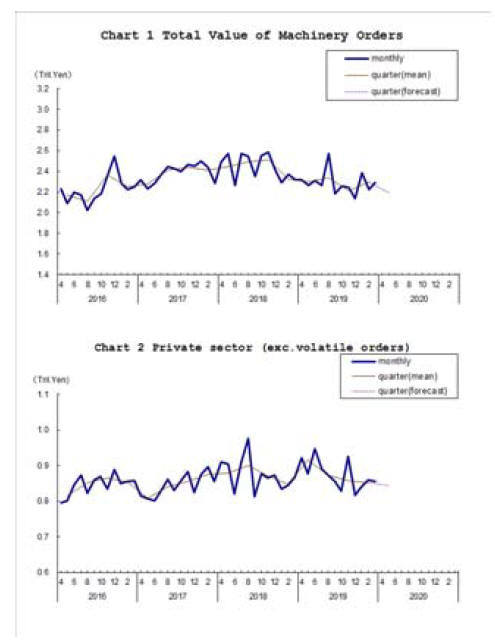
Uptick in consumer confidence as pandemic
restrictions eased
Japan¡¯s Consumer Confidence index published by the
Cabinet Office rose in May, the first upward movement in
five months. Analysts put the rise down to the lifting of
the national state of emergency.
The overall sentiment index for households of two or more
people stood at 24, up from the all-time low of 21.6 set in
April. However, the May figure is the second-lowest since
April 2004 and even lower than at the start of the 2008/9
financial crisis.
The index is intended to provide an indication of
consumers¡¯ expectations for the coming six months. A
reading below 50 indicates that pessimists outnumber
optimists. The index for willingness to purchase durable
goods (such as household furniture) trended higher but is
still deeply in negative territory.

Yen/dollar exchange rate steady while other
major
currencies fall
While many emerging market currencies have depreciated
sharply the major currencies, despite the pummeling of
their economies by the pandemic, have continued to trade
in a narrow band unlike the volatility during the 2008
financial crisis. Nowhere is the stability of a major
currency more apparent than with the yen/dollar exchange
rate.
After Lehman¡¯s collapse the yen swung to 89 to the dollar
from around yen 110, an appreciation of 24%. But during
the first quarter of the current pandemic the yen/dollar
exchange rate has remained remarkably stable in a range
from yen 106 to yen 109 to the dollar. In contrast, the
euro, sterling, and Australian dollar exchange rates have
all declined steeply.
The strength of the yen has happened despite the overall
weakness of the Japanese economy, a weakness that was
apparent even before the coronavirus pandemic.
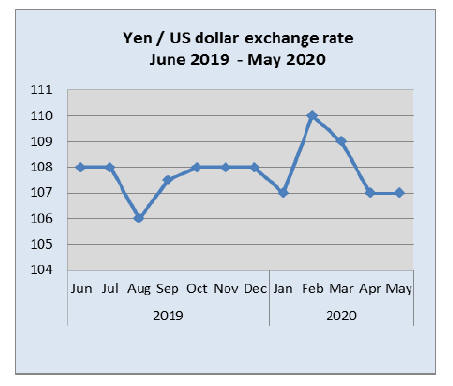
Housing starts beat expectations
Housing starts across Japan fell almost 10% year on year
in April, the ninth consecutive decline but this was much
less of a fall than had been expected. Compared to the
76,600 units completed in March there were only 69,200
completions in April.
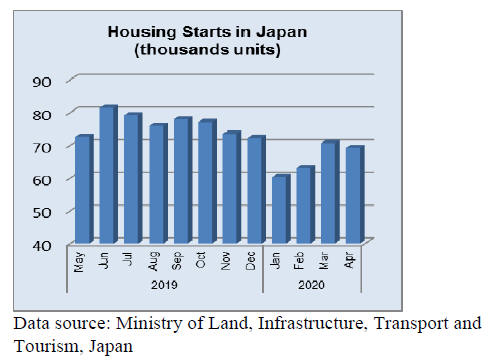
Import update
Wooden door imports
While the sharp drop in imports of wooden door
(HS441820) in February the rebound in the value in March
was more of a surprise. Year on year, the value of wooden
door imports in March dropped a further 18% adding to
the year on year decline seen in February. For the first
quarter 2020 there was a 22% decline in the value of
wooden door imports.
As in previous months shippers in China and the
Philippines dominated Japan¡¯s March 2020 imports of
wooden doors (HS441820). The main shipper, China,
accounted for 47% of all door imports. Shippers in the
Philippines saw a decline in market share in March,
slipping to 24% from the 35% in February. The other
major shipper was Indonesia which accounted for 7.5% of
the value of imports in March.

Wooden window imports
As was the case with door imports, the value of wooden
window imports (HS441810) in March 2020 was
significantly up on February rising almost 5% month on
month. However, year on year March wooden window
import values were down 12% and for the first quarter
Japan¡¯s wooden window imports were down 21%
compared to the first quarter 2019.
As in previous months the main suppliers of wooden
windows in March 2020 were China (39% of imports), the
US (32%) and the Philippines (18%). Month on month
March 2020 import values surged almost 50%.

Assembled wooden flooring imports
Japan¡¯s imports of assembled flooring (HS441871-79) in
February followed the regular peak and dip scenario and
did not showing any signs of decline which was something
of a surprise. Although orders delivered in February would
have been placed before the pandemic there could have
been some disruptions due to shipping delays but this
appears not to have been the case.
However, the impact of shipping and production delays in
China feed through into the March import data where,
instead of maintaining the peaks and dips observed over
the years, there was a double dip in February and March.
Month on month March import values dropped 21% but
year on year there was little change. Remarkably, there
was a slight rise in the value of first quarter flooring
imports compared to the first quarter 2019.
Of the four categories of flooring tracked, HS441875
made up almost 80% of all wood flooring imports and of
the China shipped 57% with another 21% arriving from
Malaysia.
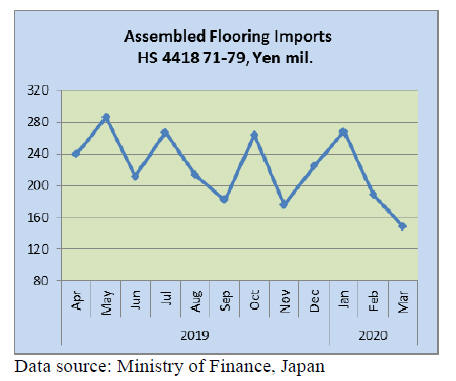
Plywood imports
Year on year the volume of Japan¡¯s March 2020 imports
of plywood (HS441210-39) rose 21% and there was a 10%
month on month increase in import volumes.
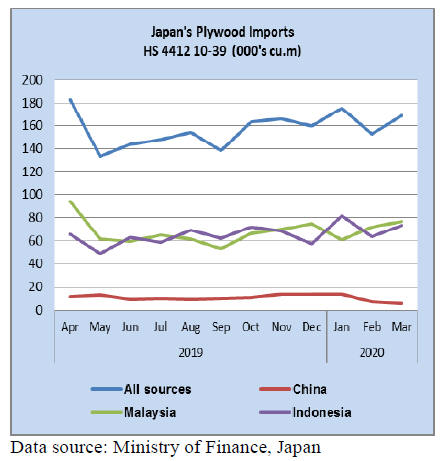
Of the various categories of plywood being tracked
HS441231 accounted for over 90% of March imports.
Year on year, shipments from the main suppliers
Malaysia, Indonesia, China and Vietnam increased but the
month on month change was more variable. Month on
month shipments from China dropped while for all of the
other main suppliers there was an increase.
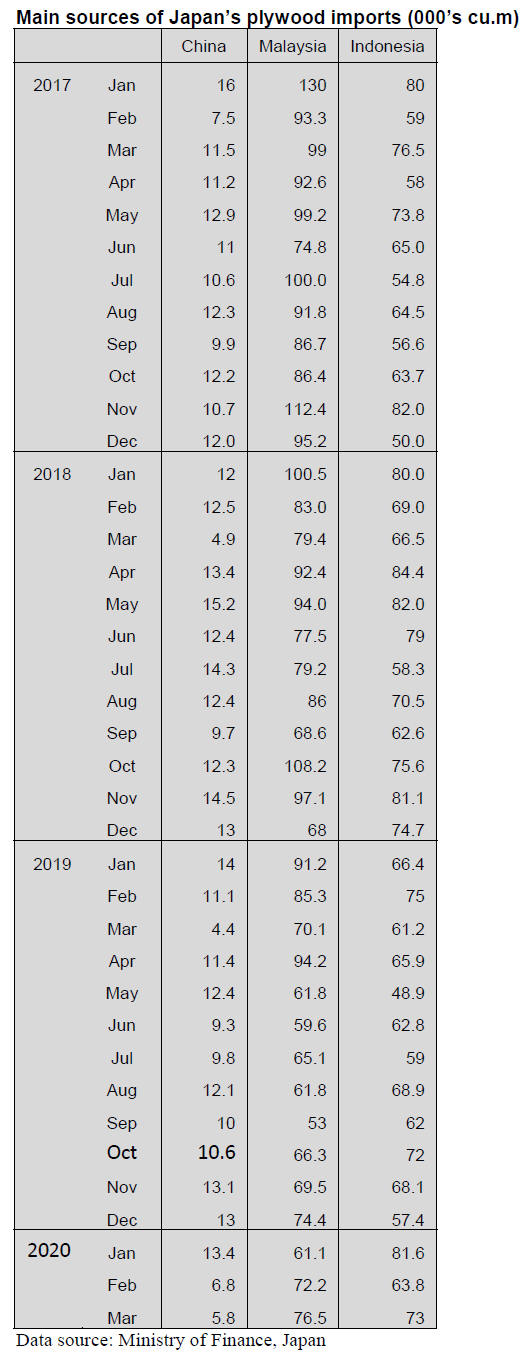
Trade news from the Japan Lumber Reports
(JLR)
The Japan Lumber Reports (JLR), a subscription trade
journal published every two weeks in English, is
generously allowing the ITTO Tropical Timber Market
Report to reproduce news on the Japanese market
precisely as it appears in the JLR.
For the JLR report please see:
http://www.n-mokuzai.com/modules/general/index.php?id=7
Increasing bankruptcies due to corona virus pandemic
Tokyo Research, credit standing investigating company,
disclosed on May 1 about bankruptcies related to corona
virus pandemic. It reports that total bankruptcies are 114.
By business categories, hotels and restaurants are the
hardest hit by dropped cash revenue as people stay at
home and many shops closed voluntarily. There are three
bankruptcies in wood related industry.
Number of bankruptcies was two in February, 23 in March
and soared to 84 in April so total exceeded 100 in 2020.
By the regions, Tokyo is the most with 26 then 11 in
Hokkaido. Hotels are 26, restaurants are 16 and apparel
related business is 10 by sudden stop of visitors from
overseas. These are all with liabilities of over 10 million
yen and there are many bankruptcies of privately owned
small business with smaller liabilities and the number will
increase month after month.
In wood business, one in Hokkaido is Kususe lumber,
whose liabilities are 140 million yen. In Tokyo, Pan
Living, disaster prevention plywood processor went
bankruptcy with total liabilities of 820 million yen.
In early May, there was a series of holidays, which is the
most busy season for hotels, restaurants and tourist visiting
places but this year, there was strong request by the
authorities to stay home to prevent infections of corona
virus and crowd decreased by 70-80% in the most bustling
part of town in the first week of May. Many shops and
stores immediately face shortage of cash flow without any
sales.
In wood related industry, sales of building materials would
drop for sure as many housing and building construction
works stopped so sharp drop of sales cause difficulty of
financing and there will be more bankruptcies in coming
months.
Japan¡¯s log export to China
In China, operational rate of sawmills were down to 20%
in late February because of corona virus pandemic but in
April it recovered to 70-80% while radiate pine log export
stopped by corona virus infections in New Zealand so
China looks for logs elsewhere and showed more interest
to Japanese cedar logs and April export log prices were
about 7,500 yen per cbm or US$118-120 C&F and there
are contracts through June.
However, future is uncertain since New Zealand restarts
log export after lockdown is partially cancelled and
economic activities are getting active.
Domestic demand has priority for log supply in New
Zealand so active log export to China may not start so
soon yet but China prefers radiate pine logs to Japanese
cedar so Japanese log export depends on New Zealand log
supply.
Also if Chinese export business dwindles, demand for
export crating lumber and pallet would decrease then
demand for Japanese cedar logs would decline.
Problem of overseas market is not all for future cedar log
supply. In Japan, low grade log demand for export
recovered but demand for higher grade A and B class logs
for lumber and plywood manufacturing continues slow. In
total harvest, A and B class logs take about over 50% so if
higher grade log prices drop, total harvest would decrease
as log suppliers lose money then low grade logs supply
decrease. In short, there are many uncertain factors in this
business.
Plywood
Movement of plywood is stagnating because of uncertain
future of the market after corona virus outbreak. Users are
limiting purchase volume at minimum.
In April, orders from precutting plants were normal so the
movement was rather firm but after the state of emergency
declaration on April 6, housing companies¡¯ activities
slowed down and orders for precutting are declining.
Plywood manufacturers have been curtailing the
production since last March to stop skidding of market
prices and hoped to increase the prices. Declining trend
stopped but price increase was impossible.
Softwood plywood inventory increased to nearly 30,000
cbms in February but it dropped down to 17,300 cbms so
the manufacturers feel confident of production curtailment
and they will maintain the same program or increase
degree of production cutback after June.
Demand for imported plywood is hard to read as large
construction companies stopped construction works in
early May temporarily but after the works restarted
schedule is difficult to judge. Management of workers is
difficult due to corona virus infections among workers.
Port inventories continue decreasing and it is time new
orders should be placed but with uncertain market future,
it is risky to commit high priced hardwood plywood.
Maruwa Forest exports logs to Vietnam
Maruwa Forest Group (Kochi prefecture) shipped out first
export of logs to Vietnam on April 29. This is sample
shipment with two 40¡¯containers. The ship will arrive at
Haiphong, Vietnam on May 23. Logs are 28 cbms of
cypress of 2 and 3 meters with top diameter of 28 cm or
larger and cedar of 4 meter with 40 cm or larger with 27
cbms.
Cypress is preferred species but cedar is sample
shipment.
Consignee is Vinafor, former government owned company
and manages 43,400 hectares of forestland with more than
10,000 employees. Maruwa will accept two Vietnamese
workers in fall this year to cover labor shortage.
2019 wood panel and plywood review
Total supply of wooden board including plywood in 2019
was 8,842, 226 cbms, 3.3% less than 2018. This is first
decline of less than nine million cbms after three years. In
this, domestic panel was 5,171,539 cbms, 2.1% more and
imported panel was 3,670,687 cbms,10% less so share of
domestic and imports was 58.5 vs 41.5%.
The largest reason of decline of imported panel is
decreases supply of South Sea hardwood plywood, which
was 13.3% or 383,000 cbms less than 2018. The demand
in Japan stagnated while plywood producers in South East
Asian countries suffered high cost of logs and
manufacturing cost so that the orders decreased. Log
supply has been dropping by environmental restrictions so
the supply is unlikely to increase.
The producers are trying to use planted species like
eucalyptus and falcate to cover shortage of hardwood logs.
Supply of imported wooden board in 2019 was almost flat
with 2018.
Particleboard increased by 8.0% but OSB decreased by
16.0% due to supply drop from Canada. Canadian volume
was 167,462 cbms, 20.3% less while German¡¯ supply was
up by 51.1% with 38,523 cbms.
MDF supply was almost flat. In imported MDF, New
Zealand was 305,508 cbms, 10.5% less while Malaysia
was 185,947 cbms, 5.6% more. Indonesia was 64,966
cbms, 72.7% more. Demand for thin MDF is active as
domestic floor manufacturers have been replacing
imported hardwood thin plywood as floor base to
combination of MDF and domestic plywood floor base.
Meantime, domestic plywood supply increased by 3.3%,
four straight years¡¯ increase. Share of domestic plywood is
over 55% now.
Two new plywood mills started in 2020 and log supply
was steady. The shipment of plywood was also firm and
the supply and demand were well balanced so that mills¡¯
inventories had kept tight. Actually since 2016, the
inventories had been less than 0.5 month every month so
the market prices stayed firm.
Domestic wooden board supply was almost flat with only
1.8% less. There were some fluctuations of demand and
supply but the market was steady.
|